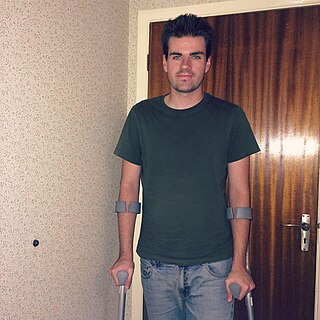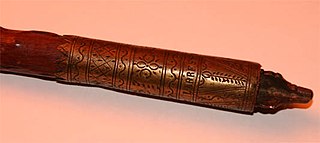A white cane is a device used by many people who are blind or visually impaired. A white cane primarily allows its user to scan their surroundings for obstacles or orientation marks, but is also helpful for onlookers in identifying the user as blind or visually impaired and taking appropriate care. The latter is the reason for the cane's white colour, which in many jurisdictions is mandatory.

The tonfa is a melee weapon with its origins in the armed component of Okinawan martial arts where it is known as the tunkua. It consists of a stick with a perpendicular handle attached a third of the way down the length of the stick, and is about 15–20 inches (380–510 mm) long. It was traditionally made from red or white oak, and wielded in pairs. The tonfa is believed to have originated in either China, Okinawa or Southeast Asia, where it is used in the respective fighting styles.

A ferrule is any of a number of types of objects, generally used for fastening, joining, sealing, or reinforcement. They are often narrow circular rings made from metal, or less commonly, plastic. Ferrules are also often referred to as eyelets or grommets within the manufacturing industry.

An ice axe is a multi-purpose hiking and climbing tool used by mountaineers in both the ascent and descent of routes that involve snow, ice, or frozen conditions. Its use depends on the terrain: in its simplest role it is used like a walking stick, with the mountaineer holding the head in the center of their uphill hand.

A splint is defined as "a rigid or flexible device that maintains in position a displaced or movable part; also used to keep in place and protect an injured part" or as "a rigid or flexible material used to protect, immobilize, or restrict motion in a part". Splints can be used for injuries that are not severe enough to immobilize the entire injured structure of the body. For instance, a splint can be used for certain fractures, soft tissue sprains, tendon injuries, or injuries awaiting orthopedic treatment. A splint may be static, not allowing motion, or dynamic, allowing controlled motion. Splints can also be used to relieve pain in damaged joints. Splints are quick and easy to apply and do not require a plastering technique. Splints are often made out of some kind of flexible material and a firm pole-like structure for stability. They often buckle or Velcro together.

A crutch is a mobility aid that transfers weight from the legs to the upper body. It is often used by people who cannot use their legs to support their weight, for reasons ranging from short-term injuries to lifelong disabilities.

A walker (North American English) or walking frame (British English) is a device that gives support to maintain balance or stability while walking, most commonly due to age-related mobility disability, including frailty. Another common equivalent term for a walker is a Zimmer(frame), a genericised trademark from Zimmer Biomet, a major manufacturer of such devices and joint replacement parts. Walking frames have two front wheels, and there are also wheeled walkers available having three or four wheels, also known as rollators.
A wrist shot is a type of hockey shot that involves using arm muscles to propel a puck forward from the concave side of the blade of a hockey stick. Generally, when the puck is shot in a similar manner using the convex side of the blade, it is referred to as a backhand shot. The power of a wrist shot comes from lower body strength more than arm strength. The advantage of a wrist shot over a slap shot is the minimal amount of setup required, creating an element of surprise. Moreover, a wrist shot is far more accurate than a slap shot. Conversely, the reliance on wrist and forearm muscles to propel the puck causes the wrist shot to be less powerful than the slap shot, though this is not true for all players, even those with "big shots". Transfer of bodyweight and the flex of a hockey stick are also key factors for a wrist shot. Weight should shift from the back leg to the front leg for maximum power. The flex of a stick is also key for a powerful wrist shot. Applying energy and weight onto your stick gives a whip like motion and thus provides your shot with even more power. The lower the flex number on a hockey stick, the more bend the stick creates.
Rebenque is the shared name in South American Spanish and Brazilian Portuguese for a type of whip used by gauchos in South America.
Spastic diplegia is a form of cerebral palsy (CP) that is a chronic neuromuscular condition of hypertonia and spasticity—manifested as an especially high and constant "tightness" or "stiffness"—in the muscles of the lower extremities of the human body, usually those of the legs, hips and pelvis. Doctor William John Little's first recorded encounter with cerebral palsy is reported to have been among children who displayed signs of spastic diplegia.

In ice hockey, players use specialized equipment both to facilitate the play of the game and for protection as this is a sport where injuries are common, therefore, all players are encouraged to protect their bodies from bruises and severe fractures.
Gait training or gait rehabilitation is the act of learning how to walk, either as a child, or, more frequently, after sustaining an injury or disability. Normal human gait is a complex process, which happens due to co-ordinated movements of the whole of the body, requiring the whole of Central Nervous System - the brain and spinal cord, to function properly. Any disease process affecting the brain, spinal cord, peripheral nerves emerging from them supplying the muscles, or the muscles itself can cause deviations of gait. The process of relearning how to walk is generally facilitated by Physiatrists or Rehabilitation medicine (PM&R) consultants, physical therapists or physiotherapists, along with occupational therapists and other allied specialists. The most common cause for gait impairment is due to an injury of one or both legs. Gait training is not simply re-educating a patient on how to walk, but also includes an initial assessment of their gait cycle - Gait analysis, creation of a plan to address the problem, as well as teaching the patient on how to walk on different surfaces. Assistive devices and splints (orthosis) are often used in gait training, especially with those who have had surgery or an injury on their legs, but also with those who have balance or strength impairments as well.

The makila is a traditional Basque walking stick, and is notable as both a practical tool and a cultural symbol of authority and strength.

A baton is a roughly cylindrical club made of wood, rubber, plastic, or metal. It is carried as a compliance tool and defensive weapon by law-enforcement officers, correctional staff, security guards and military personnel. The name baton comes from the French bâton (stick), derived from Old French Baston, from Latin bastum.

A mobility aid is a device that helps individuals with mobility impairments to walk or improve their overall mobility.
A walking stick is a device used primarily to aid walking that may also provide postural support or serve as a fashion accessory or means of self-defense.

A walking stick is a device used primarily to aid walking, provide postural stability or support, or assist in maintaining a good posture. Some designs also serve as a fashion accessory, or are used for self-defense.

Orthotics is a medical specialty that focuses on the design and application of orthoses, sometimes known as braces or calipers. An orthosis is "an externally applied device used to influence the structural and functional characteristics of the neuromuscular and skeletal systems." Orthotists are professionals who specialize in designing these braces.
A Hoople is a hoop-shaped mobility aid used by some blind and visually impaired people, and was designed to help them navigate their way over rough terrain or in a rural environment. It performs a similar role to a white cane, but is designed for use in conditions where using a white cane can be difficult, for example, in snow or on sand. It can also be used by young children as a pre-cane aid or by people with arthritis and other medical conditions which would make the use of a traditional cane difficult. The Hoople is designed to detect obstructions, much like cat's whiskers, through both tactile and audio feedback. Because the Hoople is moved along the ground rather than being moved from side to side like a cane, the user can also detect drops two paces ahead, narrow gaps or similar potential obstructions on either side of the path ahead. The Hoople was invented in the early 1990s by Clive Ellis and Tony Larkin, two lecturers at the Royal National College for the Blind in Hereford, United Kingdom.

Margarethe Caroline Eichler was a German inventor, instrument maker and prostheses designer. She was the first woman in Prussia to receive a patent and was also the inventor of the first practical modern hand prosthesis.
















